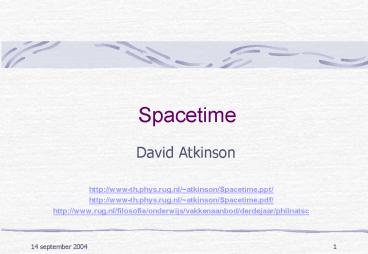Spacetime PowerPoint PPT Presentation
1 / 18
Title: Spacetime
1
Spacetime
- David Atkinson
- http//www-th.phys.rug.nl/atkinson/Spacetime.ppt/
- http//www-th.phys.rug.nl/atkinson/Spacetime.pdf/
- http//www.rug.nl/filosofie/onderwijs/vakkenaanbod
/derdejaar/philnatsc
2
The Nature of Spacetime
- Philosophy of Physics ? L. Sklar ? Chapter 2
- Traditional Philosophical Problems of Space and
Time - The Debate between Newton and Leibniz
- From Space and Time to Spacetime
- Gravity and the Curvature of Spacetime
- How Do We Know the True Geometry of the World?
- What Kind of Being Does Spacetime Have?
3
Relationism holds that space and time do not
exist in isolation from matter. Spatial relations
exist between material bodies, and temporal
relations exist between physical events. This
position was defended on philosophical grounds in
the 17th century by Leibniz in Germany and
Huygens in the Netherlands. Substantialism
holds that absolute space and time exist
independently of matter and of physical events.
This position was maintained on physical grounds
in the 17th century by Newton in England.
Idealism holds that space and time are our
mode of apperceiving the world. Space and time
are in the mind, as it were. This position was
defended by Kant in the 18th century. Relativis
m Einstein and Minkowski in the 20th century.
4
The nature of light
- Newton a light beam consists of particles in
motion - Huygens a light beam consists of waves in the
luminiferous ether
5
The nature of light
- Michelson-Morley Experiment
- The measured speed of light is independent of the
speed of the observer
6
Relative speed
- Speed of sound in air is c
- Speed of the observer relative to air is v
- Relative speed is c - v
7
Relative speed
- Speed of light measured by Bob
- is c 300 000 km / sec
- not c - v
8
Relative speed Lorentz transformation
- Assumptions
- (Empty) space is uniform
- (Empty) space is isotropic
- The speed of light is constant
- Consequences
- A moving body seems to be contracted
- A moving clock seems to go slowly
9
The moving train seems shorter than the
stationary train.
- The moving clock goes more slowly than the
stationary clocks
10
Twin paradox
- 26 signals
- 1 received at t- ceti
- 25 on return journey
11
Twin paradox
- 5 years
- outbound
- 5 years
- inbound
- 26 years on
- earth
12
Twin paradox
- Gravitation and general relativity
- Lines of simultaneity
13
Twin paradox
- m particles are made in the upper atmosphere
by collisions of protons from the solar wind
and molecules of air.
- m particles decay in a microsecond, but
they reach the surface of the earth, thanks to
time dilation what is less than one microsecond
for the particle is a minute for us.
14
Twin paradox
- The time dilation effect is taken into account
every day to help keep the atomic clocks on the
24 Global Positioning System (GPS) satellites
that encircle the Earth in sync with Earth-based
atomic clocks
15
The nature of spacetime Machs principle
- Two fluid bodies of the same size and nature
hover freely in space at so great a distance from
each other and from all other masses that only
those gravitational forces need be taken into
account which arise from the interaction of
different parts of the same body. Let the
distance between the two bodies be invariable,
and in neither of the bodies let there be any
relative movements of the parts with respect to
one another. But let either mass, as judged by an
observer at rest relatively to the other mass,
rotate with constant angular velocity about the
line joining the masses. This is a verifiable
relative motion of the two bodies. Now let us
imagine that each of the bodies has been surveyed
by means of measuring instruments at rest
relatively to itself, and let the surface of S1
prove to be a sphere, and that of S2 an ellipsoid
of revolution. Thereupon we put the question
What is the reason for this difference in the two
bodies? - (Einstein 1916)
16
The nature of spacetime Eötvös experiment
- There is no measurable difference between the
forces felt in a uniform gravitational fieldand
those suffered as a consequence of acceleration - The geometry of spacetime in a gravitational fild
is non-Euclidean - Clocks go slowly in a gravitational field
17
Non-Euclidean geometry
C number of matches on the circumference D
number of matches on a diameter C/D 18/6 3
Snapshot C/D 32/6 5.333...
- p C/D 3.14159265358979323846264338327950
18
Relationism holds that space and time do not
exist in isolation from matter. Spatial relations
exist between material bodies, and temporal
relations exist between physical events.
Substantialism holds that absolute space and
time exist independently of matter and of
physical events. Idealism holds that space and
time are our mode of apperceiving the world. The
position is that of Kant in the 18th century, who
thought that our cognitive structure and
perceptual apparatus are such that space is
apperceived as being three-dimensional, and such
that the axioms of Euclidean geometry apply, and
that time is apperceived as being one-dimensional
and directed. Relativism holds that space and
time can be transformed into one another, and are
perceived differently by observers moving
relatively to one another. Only four-dimensional
spacetime is real. This is the modern view,
introduced by Einstein and championed by
Minkowski. Relativism was combined with
relationism by the early Einstein, but the later
Einstein was forced back to a modified version of
substantialism.

